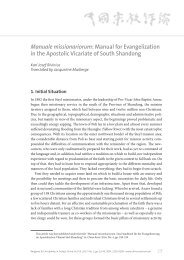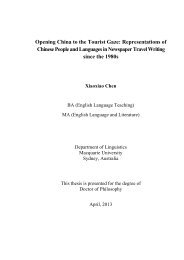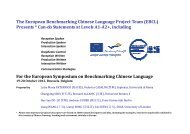EDUCATION IN CHINA
Education-in-China-a-snapshot
Education-in-China-a-snapshot
Create successful ePaper yourself
Turn your PDF publications into a flip-book with our unique Google optimized e-Paper software.
Chapter 1 – Organisation and management of education in China<br />
CURRICULUM MANAGEMENT<br />
China now utilises a three-level curriculum model<br />
consisting of curricula developed at the national level,<br />
regional level and school level. This model involves the<br />
central government, local authorities and schools in<br />
developing the most suitable curriculum for the local<br />
context.<br />
At the national level, the Ministry of Education<br />
produces the curriculum plan for elementary<br />
and secondary education, develops guidelines on<br />
curriculum management and determines the nationlevel<br />
curriculum as well as lesson hours. In addition,<br />
the Ministry of Education is responsible for setting the<br />
national curriculum standards. It also conducts pilot<br />
studies based on the curriculum evaluation system.<br />
At the provincial level, relevant authorities develop<br />
an implementation plan for the national curriculum.<br />
In doing so, provincial authorities try to interpret the<br />
intentions and objectives of the national curriculum,<br />
and to translate them into a local curriculum that fits<br />
the local context. The plan is then sent to the Ministry of<br />
Education before implementation.<br />
At the school level, schools can organise their teachers<br />
to develop their own courses and carry out educational<br />
research according to the provincial plan. During<br />
curriculum implementation and course development, the<br />
local education bureau is expected to guide and supervise<br />
the schools’ work. Schools then provide feedback about<br />
implementation.<br />
NEW CURRICULUM<br />
According to The Basic Education Curriculum Reform Outline<br />
(Ministry of Education, 2001) (Box 1.8), the primary school<br />
curriculum should consist of courses that encourage<br />
all-around development of individual learners. This<br />
document suggests that schools offer courses like morality<br />
and life, Chinese, mathematics, physical education and<br />
art to primary students in lower grades. Morality and<br />
society, Chinese, mathematics, science, foreign language,<br />
comprehensive practical activity, physical education and<br />
art should be offered to primary students in higher grades.<br />
The curriculum for junior secondary students mainly<br />
includes morality, Chinese, mathematics, foreign<br />
language, science (or physics, chemistry and biology),<br />
history and society (or history and geography), physical<br />
education and health, art and comprehensive practical<br />
activity. Schools are encouraged to choose comprehensive<br />
courses, and to offer optional courses as well. The<br />
government emphasises that Chinese, art and painting<br />
courses in compulsory education should attach more<br />
importance to Chinese character (script) writing.<br />
When it comes to senior secondary school, the<br />
government suggests that schools offer various elective<br />
subjects in addition to the compulsory subjects. The<br />
requirements in elective subjects should be different<br />
from the requirements in compulsory subjects.<br />
Throughout primary and secondary education, the<br />
comprehensive practical subject is emphasised as a<br />
compulsory subject. The subject covers information<br />
technology, research study, community service, social<br />
survey, and labour and technology for primary and<br />
junior secondary school students. It covers research<br />
study, community service and social practice for senior<br />
secondary students. The comprehensive practical subject<br />
aims at improving students’ creativity and research<br />
capability, as well as helping students develop a sense of<br />
social responsibility through practical experiences.<br />
<strong>EDUCATION</strong>AL RESEARCH<br />
The National Institution of Education Sciences, under the<br />
direct management of the Ministry of Education, is an<br />
important institution that leads educational research on<br />
various topics. It also serves as an important support to<br />
educational policy-making. The National Centre for School<br />
Curriculum and Textbook Development is also directly<br />
affiliated with the Ministry of Education. It also focuses<br />
on research but, more on curriculum and textbooks.<br />
The National Education Examinations Authority of the<br />
Ministry of Education focuses on examination.<br />
Local governments also have their own educational<br />
research institutions, which focus more on curriculum<br />
and pedagogy. At the grassroots level, every school<br />
has a “teaching study group”. These groups play an<br />
important role in educational research based on practical<br />
experiences.<br />
Non-governmental research activities have developed over<br />
the past decade. Research societies on various topics, such<br />
as higher education and teachers, have been established,<br />
and some are affiliated with the Ministry of Education.<br />
24 – <strong>EDUCATION</strong> <strong>IN</strong> CH<strong>IN</strong>A: A SNAPSHOT © OECD 2016





